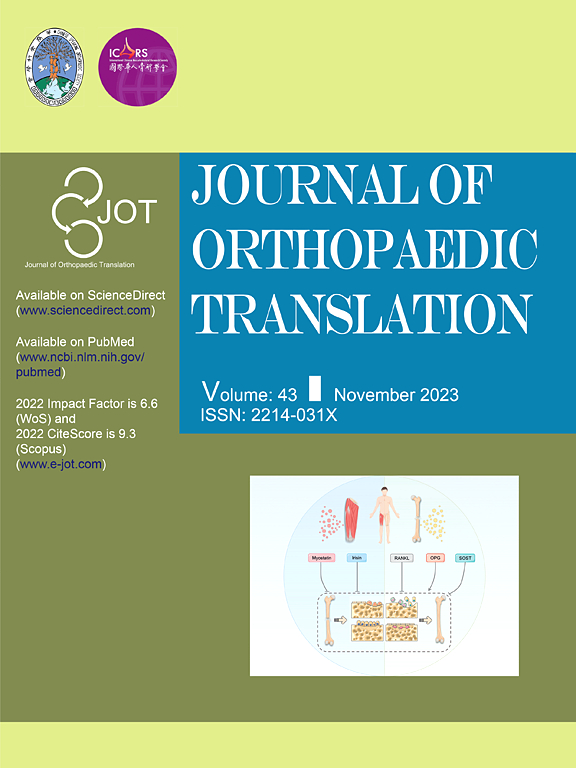骨骼肌损伤和萎缩中的细胞外基质:机制和治疗意义
IF 5.9
1区 医学
Q1 ORTHOPEDICS
引用次数: 0
摘要
细胞外基质(ECM)是一个复杂的、动态的网络,对骨骼肌细胞的结构和生化支持至关重要。骨骼肌损伤后,ECM经历快速重塑以清除受损组织,并提供支持肌肉再生的支架。ECM结构和组成的破坏导致纤维化和肌肉功能受损,从而阻碍急性损伤后骨骼肌的再生能力。此外,ECM失调还会影响肌肉质量和横截面积,导致肌肉萎缩的发生。因此,了解ECM在骨骼肌损伤和萎缩中的生理和力学作用对于制定治疗肌肉相关疾病的策略至关重要。本文就肌外基质与骨骼肌之间复杂的相互作用进行综述,旨在总结肌外基质在肌肉发育、损伤修复和萎缩等方面的调控功能和机制。此外,它还涵盖了通过利用或调节ECM成分治疗骨骼肌疾病的最新进展。我们将讨论基于ECM疗法的潜在益处以及该领域目前面临的挑战,包括生产标准化的ECM,最大限度地减少移植物抗宿主病(GVHD),并确保支架具有适当的生物学功能。总之,这篇综述将为ECM与骨骼肌之间的关系提供基础和见解,并为基于ECM的治疗肌肉损伤和萎缩的疗法的发展提供启示。本文系统探讨了ECM在肌肉发育、损伤修复和萎缩中的调控功能和机制。并从ECM的角度总结了骨骼肌损伤和萎缩的治疗策略的最新进展。本综述的见解有助于通过调节或利用ECM成分来开发骨骼肌损伤和萎缩的治疗策略,从而为组织工程和再生医学治疗肌肉相关疾病提供新的治疗途径。本文章由计算机程序翻译,如有差异,请以英文原文为准。

Extracellular matrix in skeletal muscle injury and atrophy: mechanisms and therapeutic implications
Extracellular matrix (ECM) is an intricate, dynamic network that is essential for structural and biochemical support of skeletal muscle cells. Upon skeletal muscle injury, ECM undergoes rapid remodeling to clear damaged tissue and provides a scaffold to support muscle regeneration. Disruptions in the structure and composition of ECM lead to fibrosis and impaired muscle function, consequently hindering the regenerative capability of skeletal muscle following acute injury. Besides, dysregulation of ECM can also affect muscle mass and cross-sectional area, contributing to the onset of muscle atrophy. Thus, understanding the physiological and mechanical roles of ECM in skeletal muscle injury and atrophy is crucial for developing strategies to treat muscle-related diseases. This review focuses on the complex interactions between the ECM and skeletal muscle, aiming to summarize the regulatory function and mechanism of ECM in muscle development, injury repair, and atrophy. Additionally, it covers recent advances in the treatment of skeletal muscle diseases via the utilization or modulation of ECM components. We will discuss the potential benefits of ECM-based therapies and the current challenges in this area, including producing standardized ECM, minimizing graft-versus-host disease (GVHD), and ensuring that scaffolds have the appropriate biological function. In sum, this comprehensive review will provide a foundation and insights into the relationship between ECM and skeletal muscle, shedding light on the development of ECM-based therapies in the treatment of muscle injury and atrophy.
The Translational Potential of This Article
This article systematically explores the regulatory function and mechanism of ECM in muscle development, injury repair, and atrophy. It also summarizes recent advances in therapeutic strategies for skeletal muscle injury and atrophy from the ECM perspective. Insights from this review contribute to the development of therapeutic strategies for skeletal muscle injury and atrophy by modulating or utilizing ECM components, thus providing novel therapeutic avenues for tissue engineering and regenerative medicine approaches to muscle-related disorders.
求助全文
通过发布文献求助,成功后即可免费获取论文全文。
去求助
来源期刊

Journal of Orthopaedic Translation
Medicine-Orthopedics and Sports Medicine
CiteScore
11.80
自引率
13.60%
发文量
91
审稿时长
29 days
期刊介绍:
The Journal of Orthopaedic Translation (JOT) is the official peer-reviewed, open access journal of the Chinese Speaking Orthopaedic Society (CSOS) and the International Chinese Musculoskeletal Research Society (ICMRS). It is published quarterly, in January, April, July and October, by Elsevier.
 求助内容:
求助内容: 应助结果提醒方式:
应助结果提醒方式:


